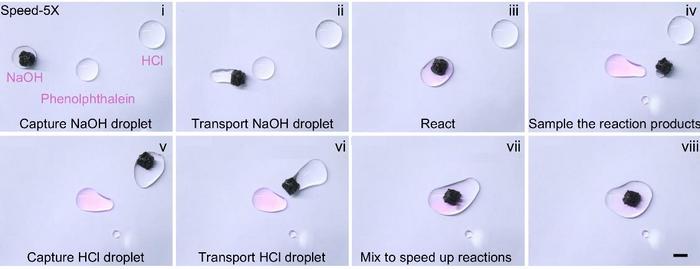In the dynamic realm of nanotechnology and precision engineering, a pioneering innovation has emerged from the laboratories of the Chinese Academy of Sciences and the China Electric Power Research Institute. Researchers have meticulously engineered a magnetic microrobot capable of manipulating microscopic droplets with precision and speed previously unachievable. This breakthrough, detailed in the upcoming issue of Nanotechnology and Precision Engineering, promises to revolutionize how fluids are handled on an ultra-small scale, potentially transforming fields ranging from medical diagnostics to industrial chemistry.
Traditional chemical processes often evoke images of large volumes of liquid mixing within familiar glassware like beakers and flasks. However, as science advances, the need to manipulate minute quantities of fluids—sometimes mere fractions of a milliliter—becomes paramount, especially in sensitive applications involving reactive chemicals or biological samples. The newly developed microrobot addresses this demand by efficiently orchestrating the movement, merging, and division of tiny fluid droplets, tasks that conventional methods struggle to perform without contamination or loss of control.
At the heart of this innovation lies a sophisticated material design. The researchers crafted a polymer matrix interspersed with neodymium magnetic particles, known for their exceptional magnetic strength. Initially, the team incorporated sugar into the polymer mixture, which was subsequently dissolved to create a porous structure. This unique porosity greatly increases the surface area of the polymer, enhancing its interaction with liquids. Furthermore, the polymer underwent plasma treatment, a process that significantly elevates its hydrophilicity, ensuring the microrobot’s surface strongly attracts water and various other fluid types.
.adsslot_QXFlKOsYPc{ width:728px !important; height:90px !important; }
@media (max-width:1199px) { .adsslot_QXFlKOsYPc{ width:468px !important; height:60px !important; } }
@media (max-width:767px) { .adsslot_QXFlKOsYPc{ width:320px !important; height:50px !important; } }
ADVERTISEMENT
The integration of neodymium magnetic particles marked a strategic advancement. Previous attempts to manipulate droplets using magnetic forces were hampered by weak magnetic responsiveness and the consequent limitation on droplet size and manipulation speed. These older systems often suffered from corrosion issues or sample pollution due to the magnetic additives used. The current microrobot bypasses these pitfalls by employing chemically stable polymers combined with robust magnets, delivering powerful magnetic actuation without compromising the integrity of the samples it interacts with.
Controlled magnetism endows the microrobot with versatile mobility. The research team demonstrated that by applying external magnetic fields, the microrobot can be precisely guided into individual fluid droplets, dragging them across surfaces or through liquids with remarkable agility. The magnetically responsive polymer coating, enhanced by plasma treatment, ensures strong adhesion to droplets, enabling not just transportation but complex manipulations such as fusion and fragmentation—all at speeds vastly superior to those of earlier magnetic microrobots.
Experimental results highlight the robot’s remarkable capabilities. The microrobot achieved velocity levels up to twenty times faster than prior models, allowing it to handle droplets approaching a milliliter in volume—an impressive scale in the context of microfluidic manipulation. Beyond speed and volume, the system’s chemical resilience allows it to operate in aggressive environments, including highly corrosive solutions like acids, without structural degradation or loss of function. This durability opens doors for its application in harsh industrial settings and sensitive medical procedures alike.
The potential applications of this microrobot extend far beyond mere laboratory curiosity. In medical diagnostics, for example, the device could automate the handling of reactive or delicate fluid samples, improving test accuracy while reducing human error and contamination risks. In industrial chemistry, the precise control of reactions at micro-scales could lead to new manufacturing processes, synthesizing compounds more efficiently and safely. Additionally, the microrobot’s ability to perform minimally invasive surgical tasks by manipulating biological fluids holds promising clinical implications.
Looking ahead, the team is actively pursuing next-generation designs that will shrink the microrobot further to enable the manipulation of nanoliter-scale droplets. Such miniaturization could accelerate developments in targeted drug delivery, where precise dosing and location-specific application are critical. Integrating advanced sensors with the microrobot might also facilitate real-time monitoring and feedback, empowering dynamic control over complex chemical or biological environments on a microscopic scale.
The material science innovations underpinning this microrobot represent a triumph of engineering ingenuity. Plasma treatment not only enhances hydrophilicity but also contributes to the longevity and functional stability of the robot in various solvents. Combining this with a chemically inert polymer framework ensures that the robot does not contaminate or degrade the fluids it handles, a common hurdle in microfluidic applications. This multi-faceted approach underlines the importance of interdisciplinary collaboration in pushing the boundaries of nanotechnology.
The implications of such technology ripple into environmental science as well. The researchers envision adaptations of their microrobot to address pollution cleanup by targeting and isolating contaminant droplets in aquatic environments. By adjusting the polymer’s surface chemistry, it could be tailored to attract specific pollutants, enabling novel remediation strategies at micro scales. This versatility emphasizes the microrobot’s role as a platform technology with vast, cross-disciplinary potential.
As precision engineering continues to evolve, the convergence of materials science, robotics, and microfluidics exemplified by this work will likely become a cornerstone of next-generation devices. This microrobot, merging physical robustness with chemical finesse, symbolizes how innovations at the nanoscale can yield transformative tools with far-reaching impacts across science, medicine, and industry. The ongoing research heralds a future where manipulating fluids with pinpoint accuracy is no longer a laboratory challenge but a practical and scalable technology.
Subject of Research: Magnetic microrobots for precise fluid manipulation at micro scales
Article Title: Hydrophilic hard-magnetic soft robots: A new approach for precise droplet manipulation
News Publication Date: June 10, 2025
Web References: https://doi.org/10.1063/5.0251223
Image Credits: Sun et al.
Keywords
Microrobots, Robots, Robotics, Engineering, Physics
Tags: applications in medical diagnosticschemical process improvementscontamination-free manipulation techniquesindustrial chemistry transformationsmagnetic microrobot technologymicroscopic fluid manipulationnanotechnology innovationsneodymium magnetic particlespolymer matrix designprecision engineering advancementsrobotic fluid mixing solutionssmall-scale fluid handling





